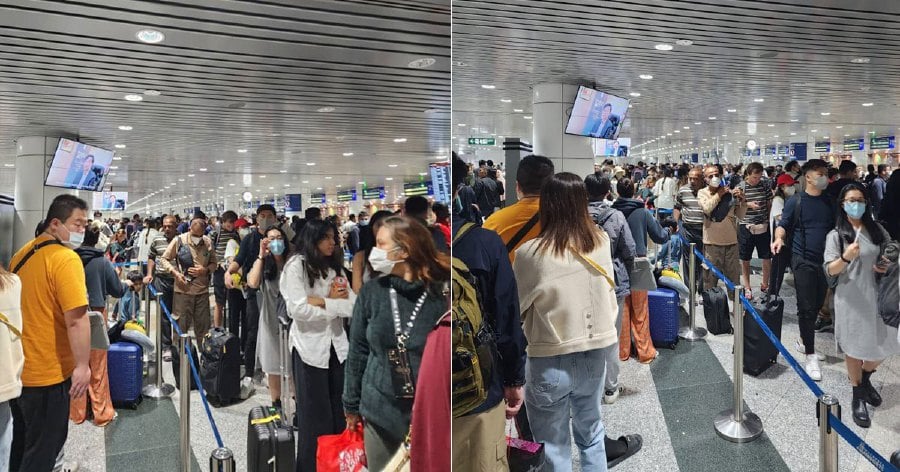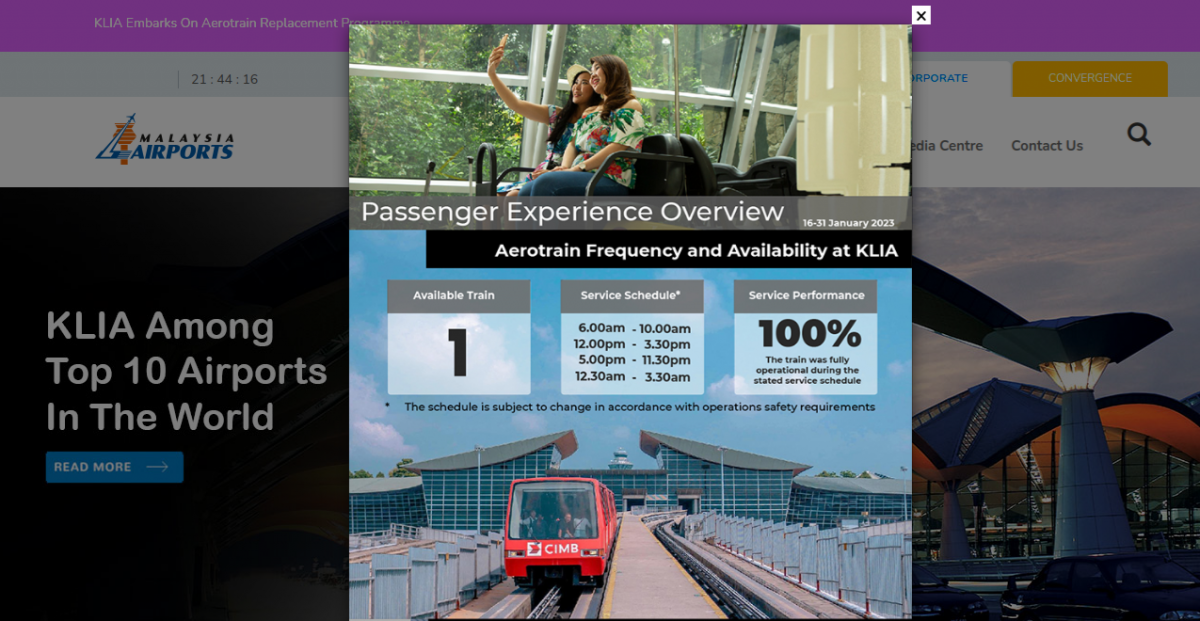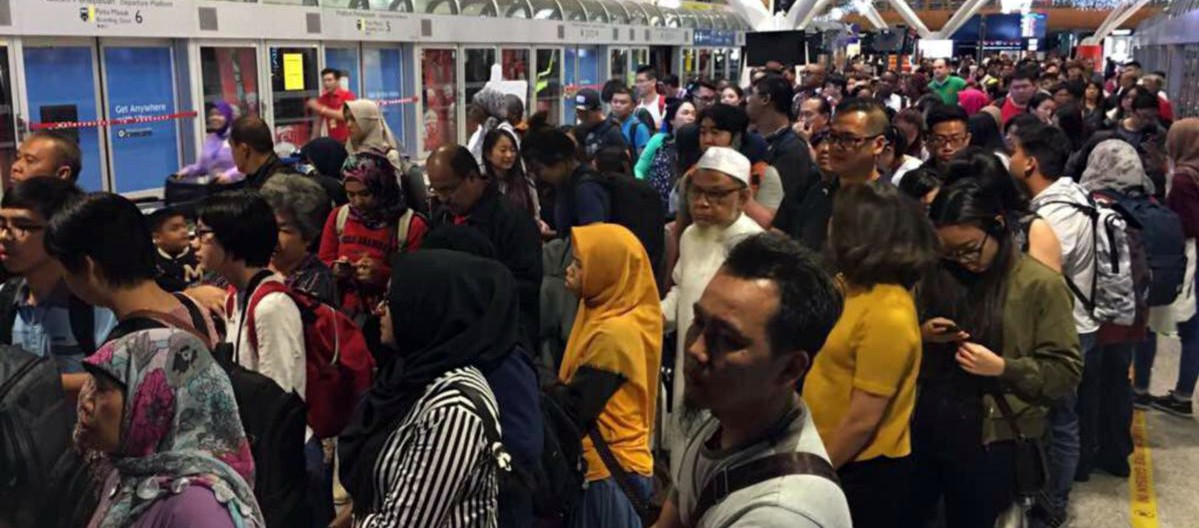From Aerotrain breakdowns and three-hour immigration queues to rude officers and long waits for luggage, Malaysia’s flagship airport is simply not getting the job done.
“The CEO of Malaysia Airports should resign!”
This was the first comment we got — from a Malaysian, no less — when asking people about the latest episode from the ongoing saga involving Kuala Lumpur International Airport.
It wasn’t the only one, however. Twitter user @happypankaj said: “The whole Malaysia Airports board ought to be sacked while the CEO (chief executive officer) dismissed. Total failure.”
Other Malaysians blasted the airport operator for the latest Aerotrain debacle, which they said had brought shame to the country.
A SERIES OF UNFORTUNATE (AND AVOIDABLE) EVENTS
The country hadn’t even gotten over the embarrassment of videos posted by disgruntled incoming visitors to Malaysia of epic, hours-long queues at the understaffed KLIA immigration counters and reports of inconsiderate immigration officers when the airport’s automated Aerotrain started having more breakdowns than usual. (Malfunctions and disruptions of the train service are nothing new; the feature image in this story is taken from what was a series of breakdowns during the Christmas holiday season in 2017.)
The most recent troubles for the Aerotrain, however, hit a new low last week as photos and videos of passengers trudging along the train tracks after two trains failed went viral and put the airport’s management in the crosshairs of numerous critics. But it’s safe to say that the PR problems for KLIA had already been growing.

The long processing times at Immigration counters resulted in a storm of negative press for the country in February. Tourism Minister Datuk Seri Tiong King Sing called out the Immigration Department for their poor performance at KLIA, and Malaysians were happy to pile on with pointed criticisms of their own. Several of their comments were republished in an article by NST:
Facebook user Dingum Ting (@dingumting) said there was no improvement towards the long-standing issue, even though it had been raised by several authorities.
“Our minister already warned last month and yet there is no improvement at all. Malaysia’s image is already tarnished by our immigration. It sucks as millions have been spent to improve the system. The Home Minister, please act on it fast.”
User Oon Kin Khong (@oonkinhong), meanwhile, said travellers visiting Malaysia could lose interest in visiting the country due to the long wait. “This [the long wait] is the first impression given to foreigners. Buck up or we will soon lose tourists to neighbouring countries.”
At the same time, another user Daniel Goh (@danielgoh) said the country was known for its slow maintenance and upkeep of its system.
“Malaysia is excellent in building infrastructure, but one of the worst in the world in terms of operation, upkeep, and maintenance.”
(Interestingly enough, pretty much this exact same point was made 17 years ago by former Prime Minister Abdullah Ahmad Badawi during a speech he gave in January 2006. In that speech, referencing Malaysia’s strengths and weaknesses in building and maintaining infrastructure, he said, “We are good at building things, but not so good at maintaining and servicing them. We must have the discipline to maintain what we have built, and the commitment to provide the service that people expect and deserve.”)

The KLIA Aerotrain runs between the main terminal building and the airport’s satellite terminal. According to the airport’s website, “Starting on an elevated track from the Contact Pier (serves as the domestic terminal and international of KLIA), the Aerotrain travels into a tunnel that runs underneath an airport taxiway and then travel into the Satellite Building. The Satellite Building is accommodates flights for international departing and arriving at KLIA.”
The information continues, “The journey between these terminals takes around 2.5 minutes and the Aerotrain operates at three to five minutes intervals. This three-car, 250-passenger capacity train is fully automated and driverless and able to transport 3,000 passengers per hour, per direction — with a maximum speed of 56 km/h (35 mph).”
Though the total distance covered by the Aerotrain is not noted on the site, a simple bit of arithmetic suggests that it would be about 2.3 km — give or take. The point is, it’s not a trivial distance, something which became particularly relevant for an unfortunate group of passengers who were stranded midway between the main terminal and the satellite terminal. Eventually, they had to disembark from the train and walk along the track all the way to the terminal… in the rain.
‘A BIG, NATIONAL EMBARRASSMENT’
If you think this is more than a bit of a disgrace, you’re not alone. Former Bukit Bintang and Wangsa Maju MP Wee Choo Keong took to his Twitter account to express his dismay at images of passengers having to walk on the train’s elevated track in the rain following the latest breakdown.
“KLIA Aerotrain broke down again! This time halfway between Terminal C to the main terminal. Both trains broke down! Passengers have to walk all the way to the terminal. Is this how we attract tourists to visit our beautiful country? Anthony Loke (Transport Minister), what have you got to say?”
Wee wasn’t finished, either: “This event is a big, national embarrassment! Heads must roll, otherwise it will keep on happening again and again. Sack those (who are) responsible.”

Malaysia Airports Holdings Berhad (MAHB), known colloquially as Malaysia Airports, operate KLIA and many other airports in the country, and they issued an apology to the passengers who were impacted by the Aerotrain’s technical issues.
MAHB said on its official Facebook account that the train had malfunctioned and stopped midway on the tracks from the Main Terminal Building to the Satellite Building on Monday (March 1). However, that wasn’t the end of the drama.
“We immediately sent a second train to ferry the passengers for the rest of the journey, but unfortunately, the second train also experienced technical difficulties.
“This resulted in the passengers having to walk to the Satellite Building to complete their journey,” it said. Except some didn’t get to quite “complete their journey” as they had planned.
“We are also getting the airlines’ help to facilitate passengers who may have missed their flights due to the situation,” MAHB concluded.
STILL MORE QUESTIONS
Now for the real head-scratcher: Following all this, the airport operator said they were suspending the KLIA Aerotrain service indefinitely, and that the trains had “reached the end” of their 25-year life cycle. Apparently, despite the 25-year notice, the trains’ failure was just as big a surprise to Malaysia Airports as airplanes full of passengers landing at the airport were to Immigration, the latter leading the Immigration Director-General to explain that the hours-long queues at checkpoints were due to “a large number of arrivals.“
So, a few observations — some of our own, and some from comments we’ve received.
First, all airlines publish their schedules well in advance. There is, therefore, no real reason for Immigration officials at any airport to be stunned or taken by surprise when three or four widebody planes all arrive within 30 minutes of each other. This information is made available long ahead of time, so it should be fairly straightforward for airports to plan in advance — and to staff accordingly.
Second, what exactly have MAHB been doing for the last three years? With relatively little passenger traffic, would that not have been an ideal time to assess the Aerotrain’s “life cycle” and begin upgrading and/or replacement works? According to statements, the replacement exercise is now currently only in the “design” phase and the new trains — at this point — are not expected to be deployed until March 2025 at the earliest. If the trains were known to be approaching the end of their designed lifespan, then why wait until they’re completely broken down to even start the replacement process? Should this not have been foreseen?
Third, as one reader pointed out to us, even now if you go to the Malaysia Airports website, the main splash on the landing page shows that the Aerotrain is running 100% of the time — but that is based only on the dates of January 16-31, 2023. It’s now March, and the train has broken down to the point where it’s been taken out of service, so it may be time for an update.
Perhaps the most scathing comment from the reader: “Is this why visitors to Malaysia have to pay a tourist tax? So they can walk in the rain along train tracks at the country’s most important international airport? So they can spend hours waiting in line to clear immigration?”
The same comment also pointed out that MAHB now says that, at KLIA, 40 minutes is the time for the arrival of the first bag after a plane lands. However, when KLIA opened, he said, that target time was only 16 minutes. If that’s true, it would certainly indicate a trendline that’s going rather badly in the wrong direction.

Additionally — and brought to our attention by another reader — MAHB’s site notes that KLIA is in the “Top 10 Airports in the World.” The reader said it was hard to reconcile that claim with the recent debacles with Immigration and the Aerotrain, so we checked.
Sure enough, the ranking was both specific (for airports with over 40 million passenger movements per annum) and also from the past, specifically from Q1 of 2021. It’s admittedly a curious period for ranking airports, because, as you may recall, virtually nobody was flying at that time, as borders were still closed and the Covid situation was still plenty bad. We can’t imagine KLIA’s Q1 2023 ranking will be quite as favourable.
We also did find a post on the MAHB site noting that the Aerotrain’s “asset replacement programme” actually kicked off in September 2022, several months before the latest batch of problems.
According to the post, “As part of efforts to enhance passenger experience and to rejuvenate KLIA, Malaysia Airports Holdings Berhad (Malaysia Airports) has embarked on the Aerotrain replacement programme. The entire asset replacement programme will take three years and is scheduled to complete by March 2025. During this transition period, its current Aerotrain service will run on a limited schedule augmented with round the clock bus services so that passengers can be assured of a seamless airport journey.”
But it still remains a relevant question: Why wasn’t this three-year programme begun earlier? Even during the total lockdown period during the MCO, people were still working remotely, and the design phase could have proceeded at perhaps at least a scaled-back rate, with the implementation phase commencing once movement restrictions were relaxed.
Netizens have urged the relevant government ministries — including Transport, Immigration/Home Ministry, and Tourism — to not only seek answers to these questions, but to take action and put the country’s flagship airport back on the right path.
KLIA has long been a beautiful and enjoyable airport (at least most of the time), and Malaysia has rightly taken much pride in it, so it is our hope that swift corrective measures are taken to address these fairly serious shortcomings so that Malaysia’s flagship point of entry for international air passengers again becomes a source of pride for the country.
"ExpatGo welcomes and encourages comments, input, and divergent opinions. However, we kindly request that you use suitable language in your comments, and refrain from any sort of personal attack, hate speech, or disparaging rhetoric. Comments not in line with this are subject to removal from the site. "





















